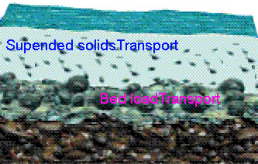The FOEN operates nationwide monitoring networks for sediment transported in bodies of water.
To monitor the sediment transported in Swiss watercourses, concentrations of suspended solids and turbidity are measured and quantities of bed load matter in bed load traps are recorded. In previous years, river deltas were also surveyed. The data from the surveys can be obtained from the FOEN.

Definition of sediment transport
Bed load is transported along the beds of streams and rivers. It is composed of sand, coarser bed load and even blocks. Suspended solids are fine particles of clay and mud, and also take the form of sand in rivers with larger slopes and mountain streams.
Feststoffbeobachtung in der Schweiz
This publication does not exist in English. It is available in other languages. 2005
The importance of monitoring sediment
Knowledge of sediment transport in bodies of water is important from both a scientific and economic perspective. For example, this knowledge makes it possible to:
- recognise risks, such as the risk of landslides for bridges or the risk of bank slides, etc.
- calculate the period of time until reservoirs and lakes silt up,
- recognise potential changes in riverbeds and deltas in the renaturation process of a body of water,
- control the accumulation of mud in river beds, which prevents groundwater recharge,
- plan protective measures for technical installations and calculate the filters for sand installations and water catchments,
- monitor potential long-term changes in sediment transport (suspended solids and bed load)
Information on the individual monitoring networks:
Bed load monitoring network
The BAFU records the quantities of bed load transported into approximately 100 bed load traps. The cantons and research institutes provide the FOEN with the figures for the transported and trapped bed loads, which are estimated with survey tools or when the bed load traps are emptied.
Suspended sediment monitoring network
Suspended solids monitoring began in the 1960s and is used to control the effectiveness of legislation to protect waterbodies and the environment.
Sampling is carried out twice per week. Specific monitoring operations are regularly carried out to record the transported suspended solids. The measured concentrations are used to determine the annual total sediment loads.
Turbidity monitoring network
Turbidity (reduced transparency) is measured in bodies of water to determine the suspended solid concentration, among other things.
The FOEN's monitoring sites are equipped with sensors that continuously measure turbidity. Turbidity is measured using a nephelometric turbidimeter. The turbidity measuring sensors, which are calibrated using a standard solution, measure the intensity of a light beam as it goes through the river water.
Delta and lake bed surveys
Monitoring changes in lake deltas is important since they can impact watercourses (changes in morphology, reduction in slopes) and the lakes themselves (accumulation of mud, changes in biospheres). The FOEN no longer performs delta and lake bed surveys at this time. However, documentation on previous surveys can be obtained from the Hydrological Data Service.
Documents
Die Mengenmässige Erfassung von Schwebstoffen und Geschiebefrachten (PDF, 9 MB, 22.03.2013)GHO Mitteilung Nr. 2
Empfehlung zur Abschätzung von Feststofffrachten in Wildbächen I (PDF, 3 MB, 26.05.2009)GHO Mitteilung Nr. 4
Empfehlung zur Abschätzung von Feststofffrachten in Wildbächen II (PDF, 13 MB, 26.05.2009)GHO Mitteilung Nr. 4
Geschiebelieferung alpiner Wildbachsysteme bei Grossereignissen (PDF, 9 MB, 02.06.2009)Ereignisanalysen und Entwicklung eines Abschätzverfahrens. Dissertation von Eva Gertsch, Universität Bern, 2009.
Feststoffverlagerung in steilen Fliessgewässern (PDF, 4 MB, 26.05.2009)GHO Mitteilung Nr. 5
Anhänge zur Dissertation von Eva Gertsch (PDF, 20 MB, 02.06.2009)Factsheets zu den untersuchten Wildbacheinzugsgebieten; Anleitung zur GIS-basierten Herleitung der Inputparameter für das Geschiebeabschätzverfahren; Vorlagen der Hang-Beurteilungsmatrix und Gerinne-Beurteilungsmatrix des Geschiebeabschätzverfahrens
Monitoring von Feststofffrachten in schweizerischen Wildbächen (PDF, 564 kB, 07.04.2010)In "Wasser, Energie, Luft", Heft 1, 2010.
Ereignisanalyse der Hochwasser vom August 2005 in Bächen des Beobachtungsnetzes der GHO (PDF, 607 kB, 19.08.2009)Studie im Auftrag des BAFU, 2009
Die Anhänge zu dieser Studie sind zu beziehen über:
hydrologie@bafu.admin.ch
Abschätzung von ereignisbasierten Feststoffvolumina in Schweizer Wildbächen mit neuronalen Netzwerken (PDF, 3 MB, 31.05.2016)Masterarbeit von Jan Baumgartner, Universität Bern, 2016
Geomorphologische Auswirkungen von Geschiebesammlern auf den Unterlauf in Wildbächen (PDF, 8 MB, 31.05.2016)Eine Untersuchung an Geschiebesammlern der Datenbank Solid. Masterarbeit von Silvia Käser, Universität Bern, 2016.
Das Modell sedFlow und Erfahrungen aus Simulationen des Geschiebetransports in fünf Gebirgsflüssen der Schweiz (PDF, 19 MB, 03.06.2016)Synthesebericht der Eidgenössischen Forschungsanstalt für Wald, Schnee und Landschaft WSL, 2015.
Datenbank Solid - Konzeptoptimierung (PDF, 1 MB, 03.06.2016)Schlussbericht, Universität Bern, 2015. Im Auftrag des BAFU
Other literature references on this subject is listed in the document below. The studies and reports are available on request from the following address: hydrologie@bafu.admin.ch.
Last modification 08.01.2024





